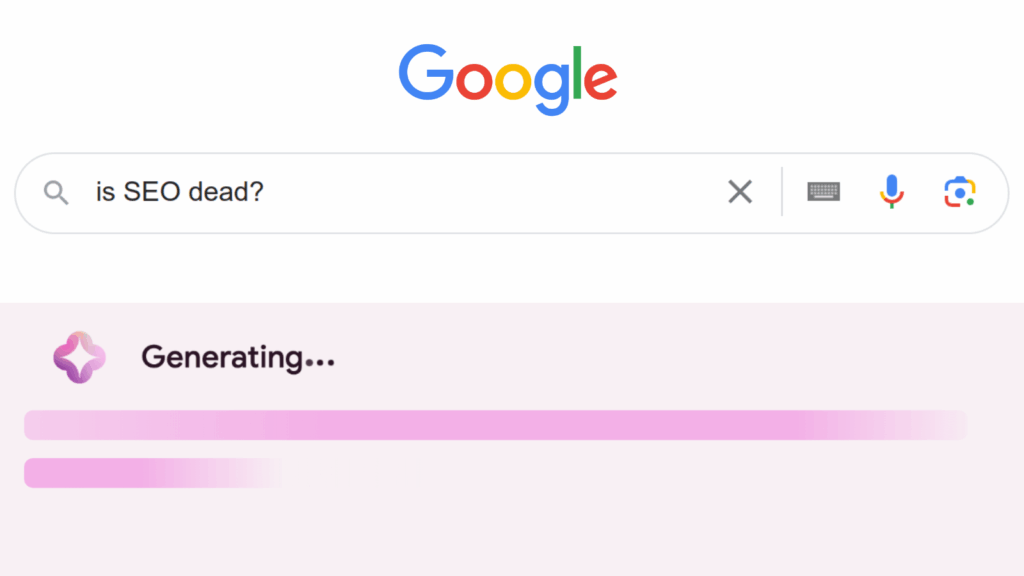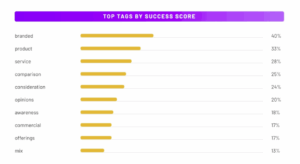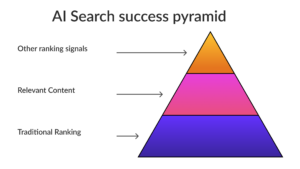The emergence of Artificial Intelligence (A.I.) has the SEO world abuzz about all the implications this has for technology, and what this means for the overall human race. From improving efficiencies tenfold, to helping assist in the creation of new ideas and new directions, the implications of artificial intelligence are numerous and spellbinding.
As positive as A.I. can be for the world, there is a much darker side to the emergence of this new paradigm, as researchers and numerous scholars continue to warn us. So much so, that it could potentially cause the extinction of the human species. In spite of the dark side, however, there are so many bright aspects.
And no field could have been as unprepared for this advanced paradigm as search has been. With Google and Microsoft entering the fray, we have seen transformative changes in the world of search, especially when it comes to Google’s SGE (search generative experience). Powered by A.I., this new user interface creates an all-new way to experience search.
Read on to find out more about how Search Generative Experience will impact Google, and all of its implications for the SEO world.
Executive summary
- SGE introduces major changes to how search works and how it looks. Answers generated by artificial intelligence are shown at the top of the search results.
- Currently, access is limited to beta testers who joined a waitlist.
- If it’s made available worldwide, we think this will have a significant impact on:
- SEO professionals: They will need to find strategies for maintaining the top positions in search results in order to keep up with competitors who are using A.I. for their own SEO. There will be no substitute for this practice.
- Website owners: SGE can greatly affect how people search the web. It pays for website owners to know how this will impact how their site will be displayed, and how to take advantage of these changes.
- Anyone else who works with Google Search for a living: SGE could greatly change tactics and how new wins are obtained. The old ways may no longer work as well, which means everyone in search will need to stay on their toes. Not just SEO professionals.
SGE Takes the Top Position (Position 0)
This is a big change. In this new layout, a text snippet generated by artificial intelligence appears at the top of the organic search results, followed by traditional results. SGE becomes the new “position 0.”
Please look at the example below:
Sample SGE A.I. results
Now let’s examine some sample A.I. search results to see how Google might look in the near future.
Query: “Best pizza near me now”
With this result, we see the new search generative experience. It’s tailored to the highly localized search query, with locations of the best pizza restaurants on the left, followed by a carousel, and the Google map on the right.
Query: “Best pizza near me with beer, no smoking allowed”
For this query, we are seeing yet another highly localized search experience generated by A.I. Compared to the standard localized search result, which only has a list of places on the left, followed by the map on the right, we now see that the new SGE shows a few more pieces of information.
First, on the left, we have the latest listings of these places, but they are followed by not only the number of star reviews but also show a review snippet. These results are then followed by a carousel on the right, along with the Google map showing the location of these places.
Clearly, Google is aiming to provide not only just the result that caters to the user’s query, but also the most helpful result that caters to the user’s query.
Query: “iPhone 13”
As a query, “iPhone 13” is primarily buyer intent focused. But, with the new SGE, this adds a layer of informative search intent to the results, providing quite the SERP that leverages both intents. The new SGE adds some pros and cons, as well as some people also ask queries below the results. In addition, the carousel that displays shows several resources users could take advantage of to find additional reviews and other information as they please.
Query: “Best smartphone up to 1000 USD”
With this query, it’s highly buyer-intent focused. But, the SGE provides all the information that a buyer might want to use to find their new best smartphone for $1,000 USD. It includes things like what you might want to consider when purchasing a smartphone, some recommendations for the best smartphone, as well as a carousel that shows top articles throughout the industry.
Query: “Google Search Console”
The query “Google Search Console” by default shows the usual top organic results, followed by “people also ask” questions. With SGE, however, it provides a more comprehensive answer to the question, which keeps people on Google search longer, thereby potentially increasing Google’s own dwell time metrics.
Observations of the Search Generative Experience
Throughout these experiments, I was able to put together a number of observations about Google’s new search generative experience, and how this will impact search results now and in the future. The ramifications that these observations present for the world of search are significant and are not to be understated.
1. SGE Shows Results for Various Types of Queries
SGE is displayed for different search intents, including informational, transactional, local, and commercial investigation. However, it’s not available for all queries.
2. SGE is not displayed for every query
Interestingly, SGE is not displayed for every search query. We don’t know if this is an experimental limitation or a deliberate design choice.
First of all, it’s not available for queries related to recent news. Here’s an example with Barcelona’s soccer results:
3. Some Queries Aren’t Covered by A.I.
There are many queries that are not covered by Google’s A.I., for reasons unknown. For example, queries like “How to prepare chicken salad” or “Stocks to buy in 2023” don’t generate SGE results.
Example: “How to prepare chicken salad”:
Example: “Stocks to buy in 2023”
Sometimes users need to click on the “Generate” button
For certain queries, SGE is uncertain whether A.I.-generated results should be shown.
When users want to get the A.I. results, they can click on the “Generate” button. Examples using Samsung and Amazon as the query illustrate this feature below:
Example: Samsung
Example: Amazon
I also noticed that for many other types of queries, Google’s SGE doesn’t generate results by default. One such example includes: “what’s batch-optimized rendering in SEO”:
4. Google’s SGE is not your father’s search
After more than 20 years of using Google’s search engine, we’re used to typing short queries containing keywords, such as: “Smartphones up to 1000 USD with a good selfie camera”.
The adoption of SGE opens up the possibility of more natural and human patterns of interaction with the search user interface.
| Before: “keyword” query | After: conversational query |
| Query: “Smartphones up to 1000 USD with a good selfie camera”. | Query: “I want to buy a good smartphone up to 1K USD, but I care only about the selfie camera, I don’t care about the main camera quality” |
Will the SGE be able to transform our 20-year-old search behavior?
Here is an example of a conversational search using SGE.
First, I told SGE that I would like to buy a smartphone for up to $1,000.00 USD, with a great rear camera:
Then I asked a follow-up question, narrowing the results to those at an $800.00-$1,000.00 USD cap:
You can ask SGE as many follow-up questions as you want.
However, it seems that SGE isn’t a fully reliable virtual assistant. I asked SGE to summarize results, with more information in a table (like I would ask ChatGPT). It failed:
5. It’s an experiment
Google’s blog post announcement says that SGE is an experiment:
“We’re starting with an experiment in Search Labs, called SGE (Search Generative Experience), available on Chrome desktop and the Google App (Android and iOS) in the U.S. (English-only at launch), so we can incorporate feedback and continue to improve the experience over time.”
That means it’s definitely not the final version, and what is ultimately released could be radically different compared to what we see today.
Google needs some time to see if users are happy with the results. Then, they will evaluate and incorporate feedback as it comes in.
We will continue to cover this topic in-depth to help you stay on top of the latest changes.
Known problems of the Search Generative Experience
Common Attribution Issues
One major drawback of Google’s SGE is that it often doesn’t attribute sources properly. I quickly noticed two queries: “What is JavaScript SEO” and “Batch optimized rendering,” in which the source is not identified. This means that there are significant issues when it comes to copyright attribution, along with legal issues (which I will not cover here).
Here is an example using the query “What is JavaScript SEO”:
There have been several mentions of this lack of attribution by a number of SEO professionals on social media sites such as Twitter. To say that they are not happy about this is an understatement. Writers and publishers will undoubtedly be negatively impacted by Google using this approach, with the lack of attribution feeling like people won’t know who is writing what articles up-front.
Clearly, the impact and negative issues surrounding the attribution issues with Google’s SGE are strong, and are something that will need to be addressed by Google at some point, if they hope to remain legitimate in the eyes of writers and publishers alike.
Quality Varies due to SGE Content Sources
Since SGE relies on artificial intelligence, the quality of its results is not peer-reviewed. The results of the SGE are based on content found on the internet, and while some resources are good, others may be of lower quality. This can lead to misinformation, as well as inconsistent quality of information.
Google even openly warns in the search result: “Generative AI is experimental. Info quality may vary”.
For the query “What is the difference between Crawled – currently not indexed” and “Discovered – currently not indexed” I noticed two inaccurate pieces of information:
Challenges with Understanding Conversational Queries
SGE still struggles with understanding some of the conversational queries. For example, when asking for a short answer to whether I can buy links, SGE wasn’t helpful, resulting in a poor user experience. SGE also thought I was asking about URL shorteners, rather than buying links. Clearly, the SGE needs a lot of work before it will be ready for prime time.
Speed Issues with SGE
SGE introduces additional waiting times of around 5-7 seconds.
Here is an example: users searching for “best pizza near me now” immediately receive recommendations from the “traditional search”. As a result, they may not be willing to wait for SGE-generated results. See the screenshot below:
SGE is not always helpful
Bartosz Goralewicz, CEO of Onely, asked SGE to find working coupon codes for a specific product. SGE generated a long list of websites that offer coupons.
Takeaways:
- SGE will be position zero (assuming the rollout goes global).
- SGE introduces many other changes. Testing SGE by SEO Pros and website owners can provide a glimpse of how Google’s new search engine user interface may work in the future.
- Currently, it’s limited to beta testers who joined a waitlist. To explore this new experience, you may want to consider signing up to the waitlist.
- SGE can change how users behave – moving away from: “keyword queries” to “conversational queries.”.
- If the rollout goes global, it may have a massive impact both on SEO professionals and website owners.







